未解之谜(玛雅文明)英语PPT
- 格式:ppt
- 大小:777.00 KB
- 文档页数:13
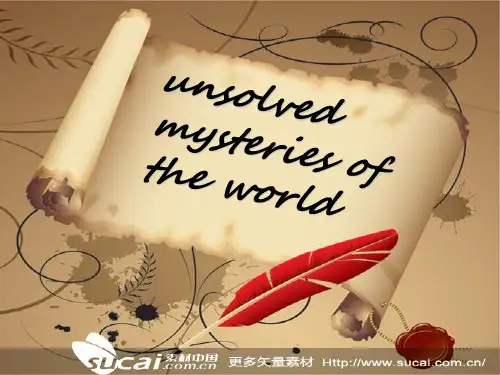

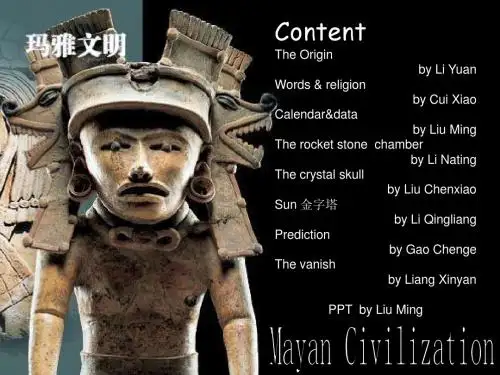

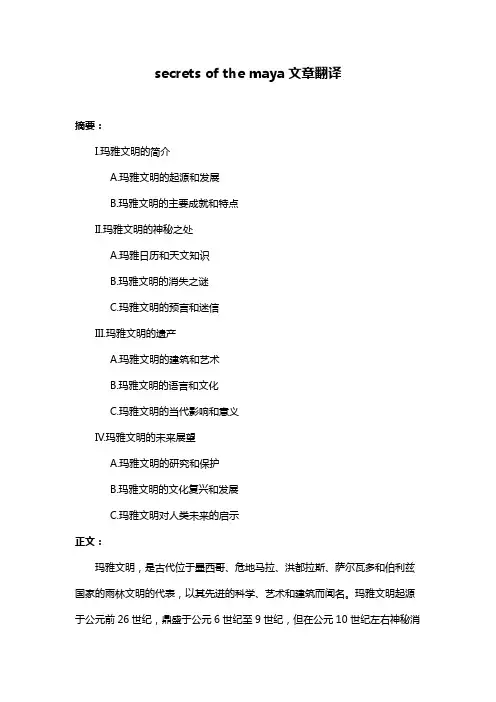
secrets of the maya文章翻译摘要:I.玛雅文明的简介A.玛雅文明的起源和发展B.玛雅文明的主要成就和特点II.玛雅文明的神秘之处A.玛雅日历和天文知识B.玛雅文明的消失之谜C.玛雅文明的预言和迷信III.玛雅文明的遗产A.玛雅文明的建筑和艺术B.玛雅文明的语言和文化C.玛雅文明的当代影响和意义IV.玛雅文明的未来展望A.玛雅文明的研究和保护B.玛雅文明的文化复兴和发展C.玛雅文明对人类未来的启示正文:玛雅文明,是古代位于墨西哥、危地马拉、洪都拉斯、萨尔瓦多和伯利兹国家的雨林文明的代表,以其先进的科学、艺术和建筑而闻名。
玛雅文明起源于公元前26世纪,鼎盛于公元6世纪至9世纪,但在公元10世纪左右神秘消失。
玛雅文明留下了许多未解之谜,引发了人们的好奇和探索。
玛雅文明的神秘之处首先体现在其日历和天文知识上。
玛雅人拥有精确的日历系统,能够预测日蚀、月蚀和金星周期等天文现象。
他们建造了许多天文观测台,通过观察天体运行,推算出各种天文数据。
玛雅文明的消失之谜也一直吸引着人们。
尽管有许多猜测,如战争、疾病、自然灾害等,但玛雅文明的消失仍然是一个未解之谜。
此外,玛雅文明还有许多预言和迷信,如2012年世界末日的预言,虽然已被证实为误传,但仍引发了人们的恐慌和讨论。
玛雅文明留下了丰富的遗产,包括宏伟的金字塔、壮观的石雕、精美的陶器和纺织品等。
这些遗产展现了玛雅文明的独特艺术风格和高度技术水平。
玛雅文明的语言和文化也影响了后来的中美洲文明。
此外,玛雅文明的神秘和独特性也吸引了大量的游客,促进了当地旅游业的发展。
展望未来,玛雅文明的研究和保护将继续进行。
科学家们通过解读玛雅文明的文字和遗址,不断揭示其神秘的面纱。
同时,玛雅文明的文化复兴和发展也备受关注。
人们希望通过研究和传承玛雅文明,找到其在现代社会的价值和意义。
总的来说,玛雅文明不仅是一个伟大的文明,也是一个充满神秘和未解之谜的文明。
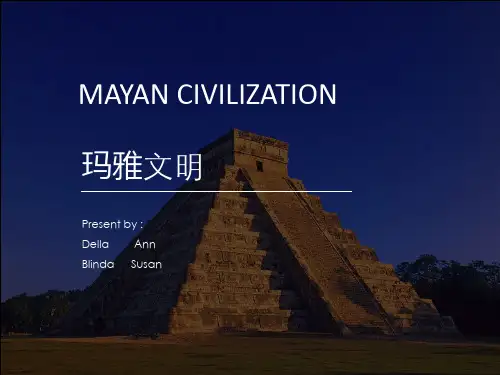
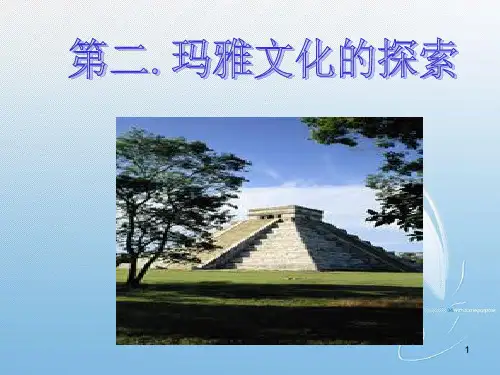

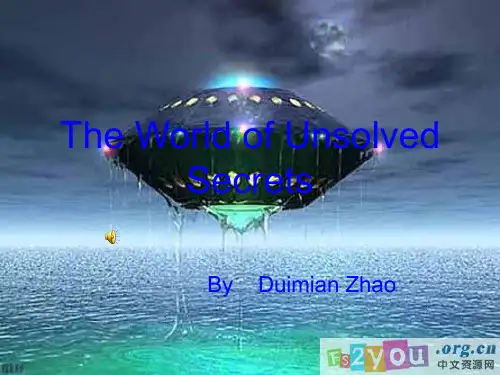

《玛雅文明的未解之谜》说课稿尊敬的各位评委、老师:大家好!今天我说课的题目是《玛雅文明的未解之谜》。
一、说教材(一)教材的地位和作用《玛雅文明的未解之谜》是一节充满神秘色彩和探索价值的课程。
玛雅文明作为世界古代文明中的璀璨明珠,其独特的文化、神秘的历法、壮观的建筑等都吸引着无数人的关注和研究。
通过对玛雅文明未解之谜的探讨,能够激发学生对历史文化的兴趣,培养他们的探究精神和批判性思维能力。
(二)教学目标1、知识与技能目标学生能够了解玛雅文明的主要成就和未解之谜,如神秘的历法、消失的原因等。
能够分析和解释一些与玛雅文明相关的现象和问题。
2、过程与方法目标通过查阅资料、小组讨论等方式,培养学生收集信息、处理信息和合作探究的能力。
3、情感态度与价值观目标激发学生对古代文明的兴趣和敬畏之情,培养学生的文化认同感和保护意识。
(三)教学重难点1、教学重点玛雅文明的主要成就,如历法、建筑、文字等。
玛雅文明未解之谜的表现和可能的解释。
2、教学难点引导学生对玛雅文明未解之谜进行合理的推测和分析,培养他们的批判性思维。
二、说教法(一)讲授法通过简洁明了的讲解,让学生对玛雅文明的基本情况有初步的了解。
(二)讨论法组织学生针对玛雅文明的未解之谜进行讨论,激发学生的思维火花,培养他们的合作与交流能力。
(三)多媒体辅助教学法运用图片、视频等多媒体资料,增强教学的直观性和趣味性,提高学生的学习积极性。
三、说学法(一)自主学习法让学生在课前查阅相关资料,初步了解玛雅文明,为课堂学习做好准备。
(二)合作学习法在课堂讨论中,学生分组合作,共同探讨问题,培养团队精神和合作能力。
(三)探究学习法鼓励学生对玛雅文明未解之谜进行深入思考和探究,培养他们的创新精神和实践能力。
四、说教学过程(一)导入新课通过展示一段关于玛雅文明遗址的视频或图片,引起学生的兴趣,从而引出本节课的主题——玛雅文明的未解之谜。
(二)知识讲解1、介绍玛雅文明的概况,包括其地理位置、发展历程和主要特点。
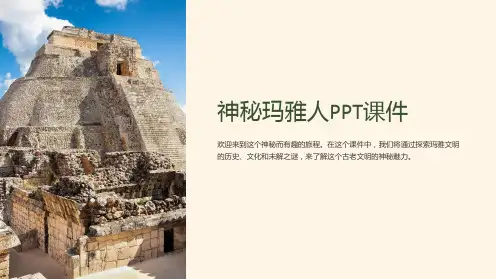
For thousands of years,Southeast Mexicoand Central Americasheltered the Maya cultureone of humanity richestand most original.Here without metal toolsor the wheel,the Maya built majestic cities.In nearby caves, descendants of the ancient Mayas pray to the gods. They have worshiped for more than 1 00 generations.Many of the citieswere abandonedinthe later ninthand early tenth century . Since that time the foresthas been the god guardianof the mystery of the Maya. Today, these ruinsare the inheritanceof the Maya people.“The drawing glyphyou asked me for is finished.”“Well, let's go seewhat the expertsin writing can tell us.”“You know what my ancestors wrotewith this glyph?”“Interesting question.”“That's been a mysteryfor hundreds of years .”“You're very muchinterested in our work.”“Yes!”“Principally,we archaeologistsare dedicatedto digging up the pastto save the mysteryof the Maya ,like a puzzlethat is solved piece by piece. ”“Only here in Chichen?”“No, no. We've been working in different sites,here, there. We've been studyingfor more than a hundred years . ”During the early 19th centuryreports of ancient monumentshidden in the junglecirculated round the world. Explorer who occasionally cameacross these ruinstried to explaintheir mysterious presencewith fantastic theories.Stories of these lost citiesattracted North AmericanJohn Lloyd Stephen ,an explorer who had publishedbooks about his travels . In 1 839, Stephensorganizedan expeditionto Central Americaaccompanied by the talentedEnglish artist, FrederickCasey Wood .He wrote the respecthe came to reel towardthe people who guided him ,and of the surpriseat what he found .He recorded all the detailsof his explorationswith great elegance.For the first timewe came to a buildingconstructedlong before the Europeansknew of the existenceof this continent.“l was filledwith amazement and admirationfor the beauty and solidityof the architecture. Here was a true palacewith royal apartmentssurroundedby magnificent courtyards.The walls and pillarswere richly ornamentedwith reliefs and figuresso beautifully createdthat it was easy to seethe artistic abilityof the Maya people.”With the aid of a camera-Lucinda -Casey Wood made many drawings.“Historians say Americawas peopled by savages ,but savages never rainedthese structures .Savages never carvedthese stones.”“Their accomplishmentswere worthyto stand beside those of Egypt,Greece and Rome.''In 1841, Stephenpublished his bookillustrated by Casey Woodand contributedimportant informationtoward the knowledgeof the Maya cities.Stephen recognizedthe native origins of the ruinsand admired the beautyof the cities.Alfred 矛德斯雷was one of the firstto study the ancient Maya citieswith a scientific approach矛德斯雷drew derailed plansand made sketchesof the monuments. In this mannerhe established a basefor laterarchaeological study.He carefully analyzedthe sculptured motifswhich decorated the wallsof the buildings. His attention was caughtby the frequent representationof the serpentThe molds of reliefand glyph which he madeenabled the studyof the inscriptions.“The best of my toolswas the camera. The dry gelatin negativehad just been inventedand this enabledphotographers to workin previouslyinaccessible places.”The major contributionof him was his photographswhich have since been used inthe restoration and preservationof many objectsbelieved tohave been lostto erosion, vandalism and theft.Some of the monumentsphotographed by him reveal the richness of designcarved in stone.For many years, it was thought that these carvingrepresented gods and priestsand that the glyphwere concerned onlywith the calendar. Much later, we came to knowtheir real significance.Some of these designswere also foundin the Maya bookswe call codices. Only four of thesehave survived.“They contain glyph ”.“We must send yoursaway for deciphering.”Most of the knowledgewe have of ancient Maya lifecomes from the writings ofa Franciscan 戴果狄兰达monk who came to Yucatanin 1 549.He used to observe the Mayaand noted their use of glyph,and latertriedto translate them into Spanish.In his writings, he established the basefor deciphering the glyphswhich were a mixtureof syllables and words.“They wrote in their booksabout their sciences.The sciences they taughtwere the countingof days, months and yearsfestivals and ceremoniescures for illnessand the art of readingand writing. We found a great numberof such books. Since they contained nothingbut the words of the devilwe burned them allwhich caused them much grief.”In his attempt to convertthe Maya to Christianity , he destroyedtheir religious possessionsburning many of the codices.“What happened to the writingif the books were destroyed?”“Fortunately, the Mayawrote not only in bookswe find writingon their stone monumentsand on potteryas on this platefound in the Yucatan area.It’s a passagefrom thea Maya legend.”The glyphwritingwas forgotten after the burningof the codices .50 years after 矛德斯雷photoswere published ,they were also used by scholarsto study the glyphand inspired many expeditionsto the region.As the first glyph were decodedit was believed that all thetexts were religious in natureconcernedwith the passage of timeand the observationof the stars. It was thoughtthe Maya were peaceful peopleliving in harmony with naturescattered in the jungle.In 1946, a discovery was madewhich cast more lighton the mystery of the Maya .The theories were aboutto dramatically change.l spent more than two years in the regionwith the Lacandon lndianfilming their daily life. l noted thatfrom time to timethe men would disappearfor a couple of day. They were making a pilgrimageto a templebut it was impossibleto follow them,so l gave them shotgunswith a smell amount powderand left for a month two. When l return they said:'' We like your guns,but we're out of powder'' . So l said''l'll give you more powder''if you'll show me more temples.”I will never forgetbeing guided to Bon Parker .They looked to the templeswith much reverence , conducting a ceremonyas we arrived at each one.As my eyes was becoming accustomedto the dim lamplight. l saw that each roomwas painted with fresh clothes that showed a fileof Maya chiefs in full regalia.These paintingschanged many of ideaswhich were held about the Maya. Never before had we seen scenesof battle, slavery and torturepainted of the Maya themselves.Ah, here's the response.So rapidly?Yes. Let's see what it says.''This is a glyph of fire,and this is a rodent''Haleb''in Mayaor 'tepescuintle' ,''but we can't knowthe full meaningwithout the missing portion.''That translation looked easy, but is was the work of peopleof many countriesover many years.The first clue to the Mayawriting was the numbers. The Maya established their unitsbased on man's 20 digits. They were oneof only four civilizationsto develop the concept of zero.Numbers were putin different positions.Dots were worth one,One, two, three, fourand five was a bar .1 5 is three bars.1 9 is three bars and four dots.20 is one dotin a higher positionwith a shell for zero below.A dotabove with a dot belowis 21. A dot above with a bar belowis 25. Two dots abovemeans two 20s, or 40. A bar in the upped positionmeans five 20s-1 00. A dot with two zeros belowis 400. A dot with three zeros belowis 8,000. 8,421.The Mayawere great mathematiciansand astronomers. They calculated the lengthof the solar yearwith an errorof only 23 seconds,the cycle of Venuswith a margin of errorof only one day in 6,000 years. Some of the buildingsof Chichenltzawere so constructedas to markthe equinox and solstices.They also knew the cycleof Mars, Jupiterand Saturnand were able to calculateeclipses of the sun33 years ahead.All this was recordedin their booksand fortunately on stone, tooIn 1921the decoding of the tabletof 96 glyphs at Palenque began.By 1 935, Enrique Palacioshad accomplished the decipheringof the first few. Eric Thomson solved othersin 1944, while the linguistYuri Knorosofdiscovered phoneticsin the Maya writing. By 1 958, half the glyphscould be read .In the '60s, Heinrich Berlinand Tatiana Proskovriokoff. In the '70s Linda Scheleand Floyd Lounsburywith Peter Mathewsdiscovered title glyphsof the royal family. Finally, in 1 990the whole panel could be readThe panel told the historyof royal family of Palenquetheir wars, andthe transmissionof power to young kings.Among these was Pacaell ruler of Pelenkui king from age of 12 and governing until 80. It was ceremony such as sticks which recorded on the stone in other Maya cities.Pelenkui was studied intensively by the Mexican national institute of anthropology and history. In 1949, the Mexican archeologist Albet Tuodus decided to investigated the temple of the descriptions, to see if it had been built on top of another building.Tudous noticed the wall of the temple did not finished at the floor, appear to continue blow. Intried he discovered that one of the huge stone slabs had flogs which able to be moved.As the slabs moved the narrow opening was revealed. A secret passage way.As we cleared the passage, several steps appeared. I immediately to follow these steps to its end, in spite the exhaustingDuring the next three years, the workfor slowly. Four hundred tons of rubble was removed by hand.By the end of the first season, we had not found a single clue.I image that these steps had been deliberately sealed to conceal their original purpose. But I have no idea what its purpose was.In 1952, when working deeply site the pyramid, we found a room seemsto have no exit.The floor was complete covered by a slabs cards stone. This slab was supported by enhanced blog with gard reliefs.Extraordinary.As the stone was liftedcentimeter by centimetermy excitement grew. A smaller lidwas hidden beneathWe had discoveredthe tomb of a kingthe first to be discoveredin a Maya pyramid. The buried king was Pacal.The scene carved on the lidof the sarcophagusdescribedthe descent of the kingon his journeyto the world of the dead. The Maya still worship the godsof the underworld Xibalba:the place of fright.When the sun slidesbelow the horizonthe sun god ltzamnabecomes jaguargod of the underworld,which has nine levelseach with its respective god. The sky has 1 3 levels.The earth is flat and ruledby Chacs, gods of rainThe physical and supernaturalworlds are interwoven.The workof archaeologists, epigraphsand scientists continues.The archaeologists use the latesttechnological advancesto assemble the jigsaw puzzleof the ancient civilization.The remains of buildingsfrom thousands of years agocan be tracedand maps of them producedwith the help of computers.“There are many siteswhich have been studied. And contrary to what wasthought for a long timethese were not onlyceremonialcenters,but real citiessome enormousand densely populated. Look, let me show you.”The Maya built many huge citiessome with populationsof about 40,000 inhabitantsruled by supreme governorthe divine Ahau. The buildingswere brilliantly coloredand covered with symbols.These marvelous citieswere abandoned . In the ninthand tenth centuries. Why, remains a mystery?The culture of the ancient Mayabuilders of the majestic citiesdisappeared.But the Maya culture, knowledgeand artistry is still presentin the life of today's Maya ,who links the past ,the present and the future.。